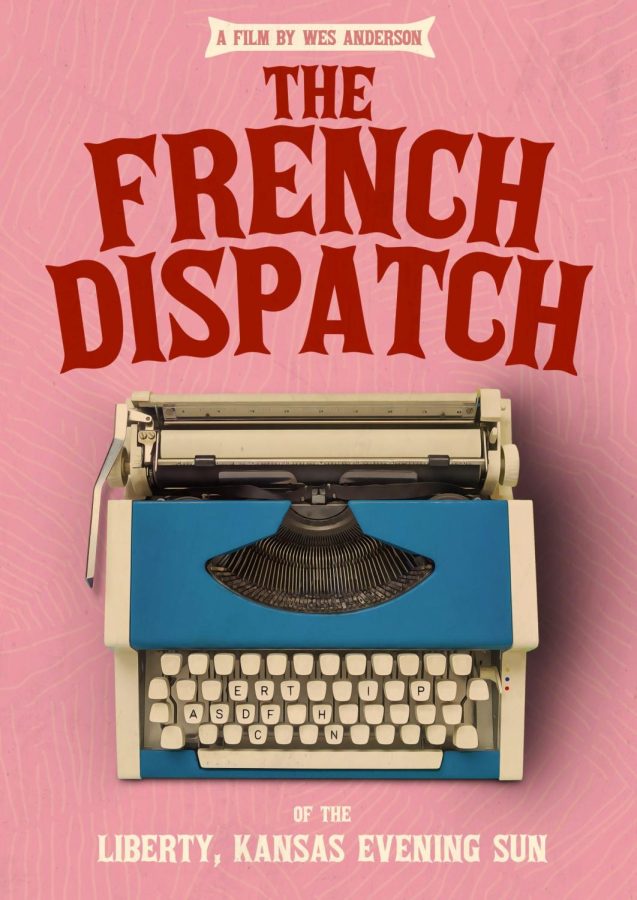The Power of the Newspaper- Reviewing Wes Anderson’s “French Dispatch”
*Possible Spoiler Warning*
“The French Dispatch” follows the journalists of the Kansas Sun newspaper’s French dispatch as they pursue their final stories to be published in the newspaper, due to the death of its editor-in-chief. Upon his death and the publication of his obituary in the newspaper, it is to be shut down.
The movie begins with the first pages of the final publication, Owen Wilson’s guide of the city of Ennui. He bikes around the city and introduces us to the city we will be spending the next hour or two with. This is a genius way to quickly show us the settings of the movie since many completely different story lines need to be tied together and implanted early into our memory. The role of Owen Wilson in this film is smaller than most of his Wes Anderson roles, more like a cameo, but still gives us his classic charm.
Then, we enjoy the Fine Arts portion of the newspaper, “The Concrete Masterpiece” discussing the works of a psychotic and genius painter who spent a long federal sentence in the city’s prison. This, at its core, is about love: the painter’s love of Simone, a prison guard who runs the art classes inside the institution and subsequently becomes his lover. While she insists she does not love him back and refuses to marry him, she is his muse and savior. His works of modern, abstract genius are all modeled on her naked body regardless of what the viewer may see in his abstract work. Upon a second watch of the film, I came to the decisive conclusion that this vignette was a masterpiece. It’s told through a presentation at the art gallery the pieces are later housed in by Tilda Swinton, who is wonderfully quirky and witty. I can see myself re-watching this particular story line hundreds of times.
The next vignette follows Timothee Chalamet and Frances McDormand during a French university student revolution in Ennui. While on the first watch I did enjoy this story line, upon a second time, I decided this was the weakest link in the film, feeling a bit immature and forced in comparison to the natural inspiration I felt during the others.
Anderson adds two new stars to his usual ensemble of actors in this film, Timothee Chalamet and Jeffrey Wright, both of who do phenomenal jobs. Chalamet does feel like a usual Anderson character, a young college student using chess to lead a revolution and defy his parents. He reminds me in many ways of the characters of “Moonrise Kingdom”, but because of this, out-of-place at some times in this story. Wright, on the other hand, adds something new. He’s a solemn character experiencing a more own-to-earth struggle than most of the other characters in this. If you were to tell me one character from “The French Dispatch” was based on a real person, I’d pick Wright’s.
Wright is the main character of our wonderful last vignette, which follows his journalistic pursuits to enjoy a police chef’s delectable on-the-job cooking. During his dinner, the police chief’s son is kidnapped, throwing us into an action-based and occasionally animated rescue and car chase.
Something I love about Anderson is his ensemble casts. Firstly, in his writing, he knows how to balance these large numbers of characters. Each feels like they’ve had enough time on screen for you to understand and fall in love with them. I also love the consistency with which he uses actors. Almost all his movies share large swaths of the same main actors, and this just reminds me of kids in high school who all just want to make movies together — a friend group all working together to create a piece of media that represents each and every one of their strengths. This can be seen in all of Anderson’s work in my opinion but really shines inside “The French Dispatch,” where unlike most of his movies many of the actors are isolated in story and scene from most of their counterparts.
“The French Dispatch” shows a beautiful mastery of the mixing of mediums, from short animated sections to black and white distorted ratio scenes. It beautifully mixes stories and plots, ranging from interviews, romances, action scenes, and presentations. If you have the chance to see it on the big screen, I highly encourage it. It’s currently only playing at a few theaters, including Landmark’s Midtown Art Cinema and AMC Phipps Plaza 14, where I saw it at both and highly enjoyed both experiences. Even if you miss the opportunity to see it in theater, I highly recommend all of Anderson’s works if you’re looking for a cozy, aesthetic movie that will remind you to enjoy love and life.
Your donation will support the student journalists of Chamblee High School Blue & Gold. Your contribution will allow us to print editions of our work and cover our annual website hosting costs. Currently, we are working to fund a Halloween satire edition.

Sirianna Blanck is a senior and editor-in-chief of the Blue & Gold. She has a strong cat obsession. In five years, she hopes to be fighting for environmental change. Her Chamblee experience has been akin to "Alice’s Adventures in Wonderland."



